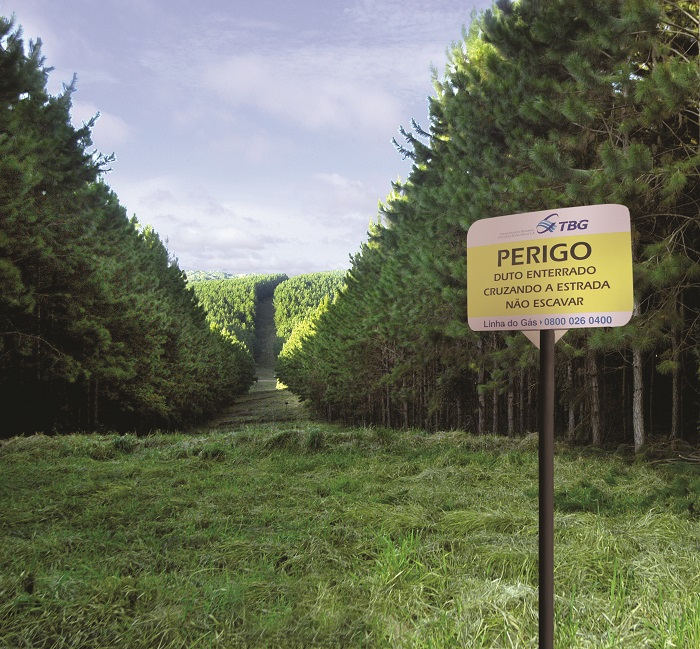Right of way
Traveling the Strip
From the Pantanal of Mato Grosso do Sul to the Pampas of Rio Grande do Sul, we witness the riches of Brazil
From Corumbá, in Mato Grosso do Sul, to Canoas, in Rio Grande do Sul, our gas pipeline is present in several regions of Brazil, comprising varied terrain, vegetation, urban centers, rivers and farms.
We cross the Pantanal of Mato Grosso do Sul, the Cerrado, the River Paraná, the River Tietê and Aparados da Serra, among other beautiful and rich locations. You may not realize it, but we are present in a great variety of places, distributing gas and development within Brazil.
In order to sustain efficient operations, based on reliability, we have teams in the field, on standby 24 hours a day, who are responsible for the supervision and maintenance of the entire path of the Gas Pipeline, carrying out periodical inspections of the right of way, installations and equipment.
Our right-of-way is a 20-meter wide strip of land that follows on the surface the underground path of the pipeline, which is essential for the safety and protection of the pipes. This strip is a right of way introduced by a Federal Decree of August 28, 1996.
The pipes are buried at an average depth of 1 meter. To protect them from possible damage, the right-of-way must always be signposted and the access must be free of obstacles along its entire length.
The Climate Notebook aims to present TBG's strategies and actions that contribute to the mitigation of climate change. The document is subdivided into nine sections, namely: Energy Scenarios in Brazil and the World, TBG Portfolio, Corporate Governance, Governance and Policies, Strategy and Investments, Performance Metrics, Emissions Management and Decarbonization Projects, Commitment to Sustainability and Recognition.
The right-of-way strip: safety and integrity of the Gas Pipeline
The right-of way is a 20-meter wide strip of land where the Pipepline is buried. This area is a right of passage granted by Federal Decree from 08/28/1996 and is essential for the safety and protection of the Pipeline. The pipes are buried at an average depth of 1 meter. To protect them from possible damages, the right-of-way must be always signposted and with free accesses in its whole extension.
The right-of-way:
Delimits and protects the Pipeline route;
Identifies the places with installed equipment;
Signs the places where excavations, constructions, occupancy and clearing land by burning are forbidden.
Right-of-way Signposting
All the signposts in the right-of-way are planned so that the nearby community knows the precise location of TBG’s Pipeline
1- Landmarks show the right-of-way limits;
2- Kilometer markers are placed along the Pipeline;
3- Signposts announce the existence of the buried pipeline, with safety warnings and signaling road and railway, transmission lines and river, lake and lagoon crossings.

The landmarks and signposts are owned by TBG* and must be preserved. If removed or damaged, they will impair TBG technicians’ routine or emergency interventions and prevent third party’s identification of the place where the Pipeline is buried.
(*) The intentional destruction of goods or properties of others may be qualified as crime, according to Art. 163 of the Criminal Code.
Right-of-way inspections
Three types of inspections are carried out:
From air, by helicopter;
Underwater, made by divers at the crossings with rivers and lakes;
From land, carried out along the pipes, by right-of-way inspectors.
Strip signage
Help the TBG to preserve the operations of the Gas Pipeline and the safety of those who live close to the strip, preventing damage to signs, markers, fences and padlocks.
Rules to be followed:
| PERMITTED | NOT PERMITTED |
|
Cultivate low-lying crops along the entire length of the strip. |
Cultivate taller crops that may block the view of the signs. |
|
Drain all of the water out of the strip, thereby avoiding erosion of the ground surface. |
Using a plough, harrow or other large item of agricultural equipment within the strip. |
|
Cross the strip on foot, by motorbike, car, jeep or cart. |
Cross the strip on a tractor or truck that weighs more than 10 tons per axle. |
In the event that any irregularity is perceived, or to clarify any doubts, please call the Linha do Gás (Gas Helpline) - 0800 026 0400, a toll-free telephone service that operates 24 hours a day, seven days a week.
Contact the TBG, by calling the Linha do Gás (Gas Helpline) - 0800 026 0400 – if you notice:
Any damage to signs;
Any kind of construction within the strip (even if temporary);
Any use of explosives in the vicinity;
Digging or fires;
Effects of nature near the strip, such as: landslides, erosion caused by rain, large fallen trees, etc.
Apresentação institucional
Cartilha “Aprendendo Sobre o Gasoduto”
Instalações de Superfície
Meio Ambiente e Você
Guia da Propriedade
Guia de Convivência
Lâmina sobre Escavação
Lâmina sobre Perfuração
Lâmina sobre Trânsito
Programa Viu-Parou
Jornal Você e a Faixa nº 15
Jornal Você e a Faixa nº 16
Jornal Você e a Faixa nº 17
Jornal Você e a Faixa nº 18
Jornal Você e a Faixa nº 19


